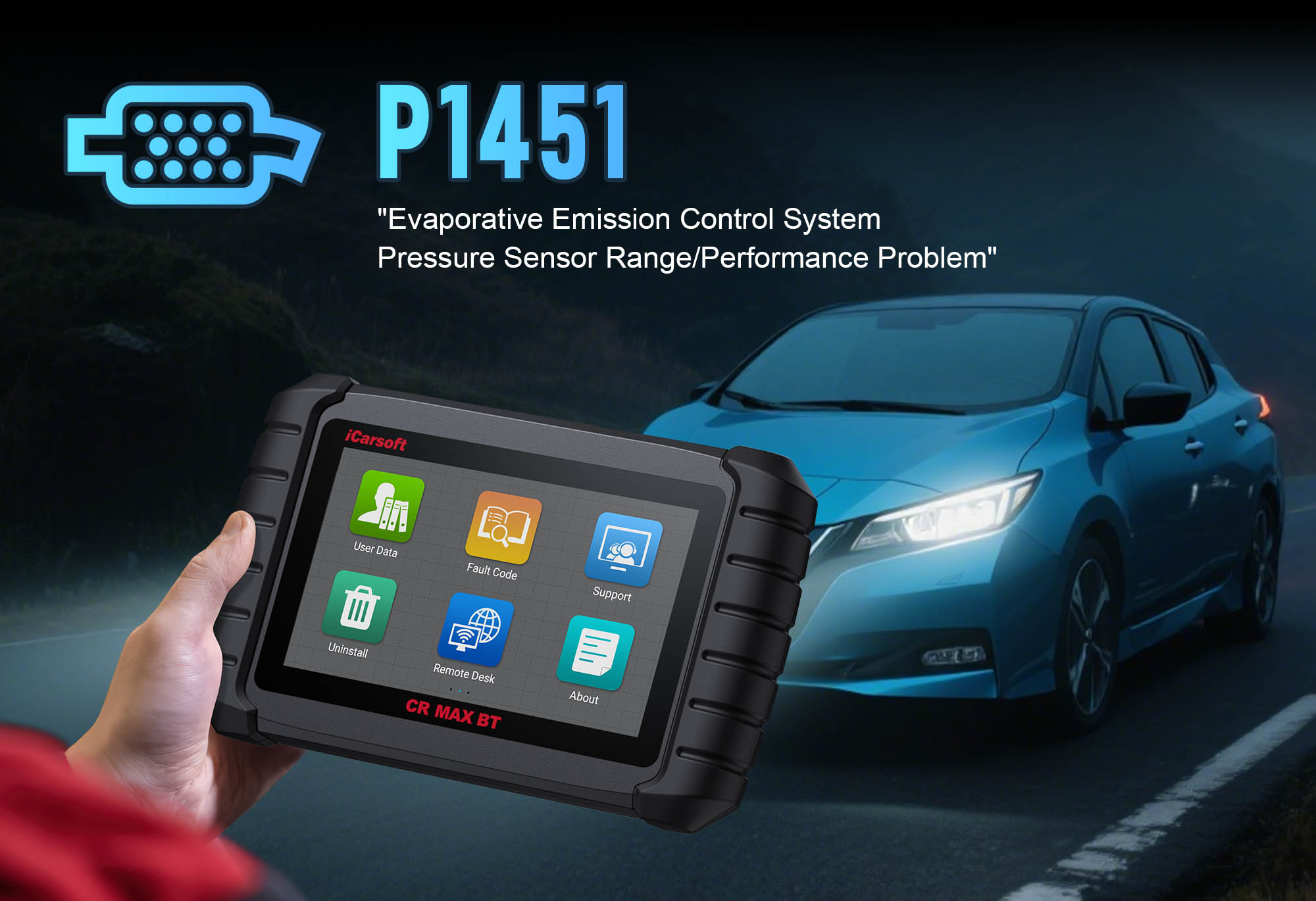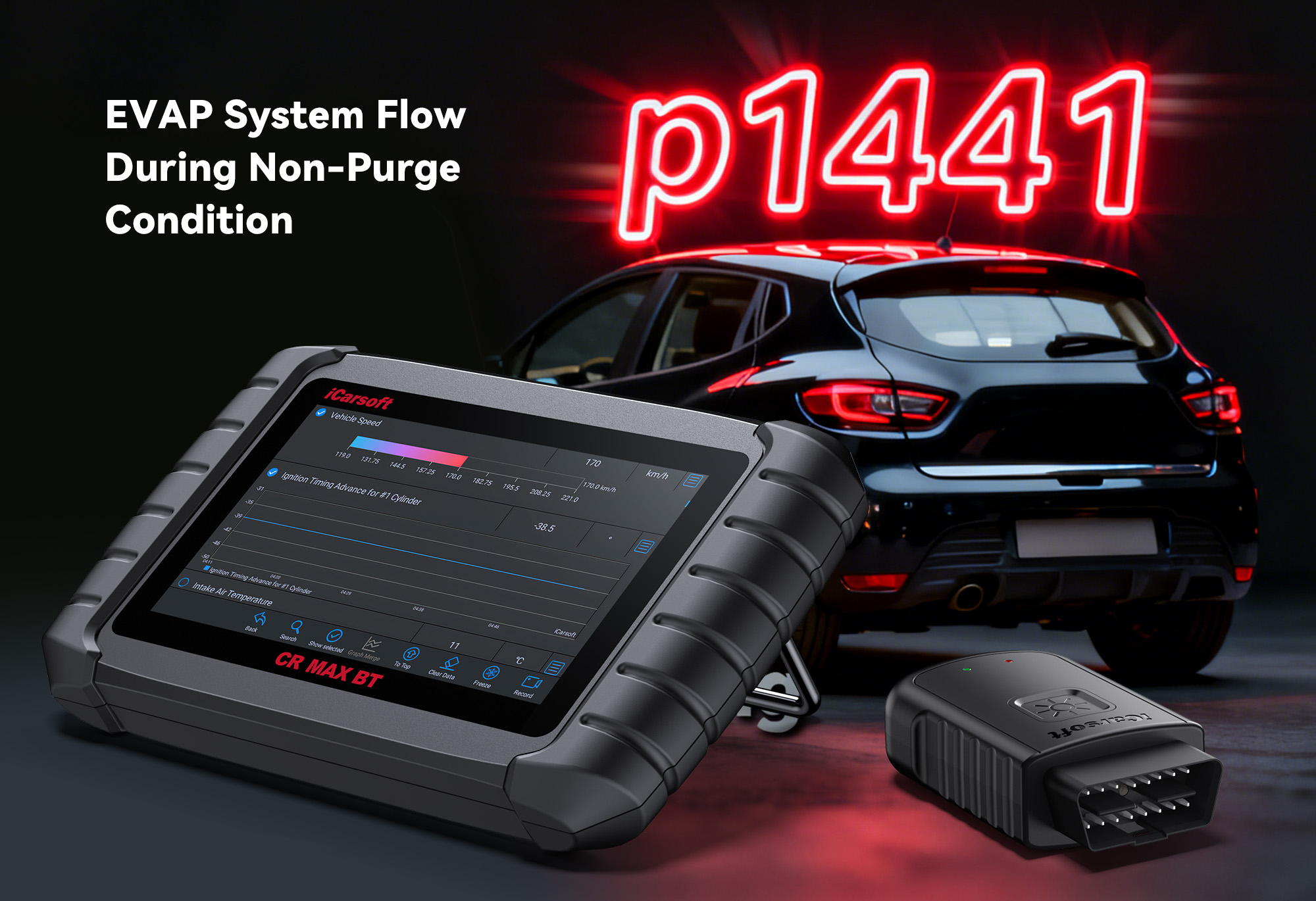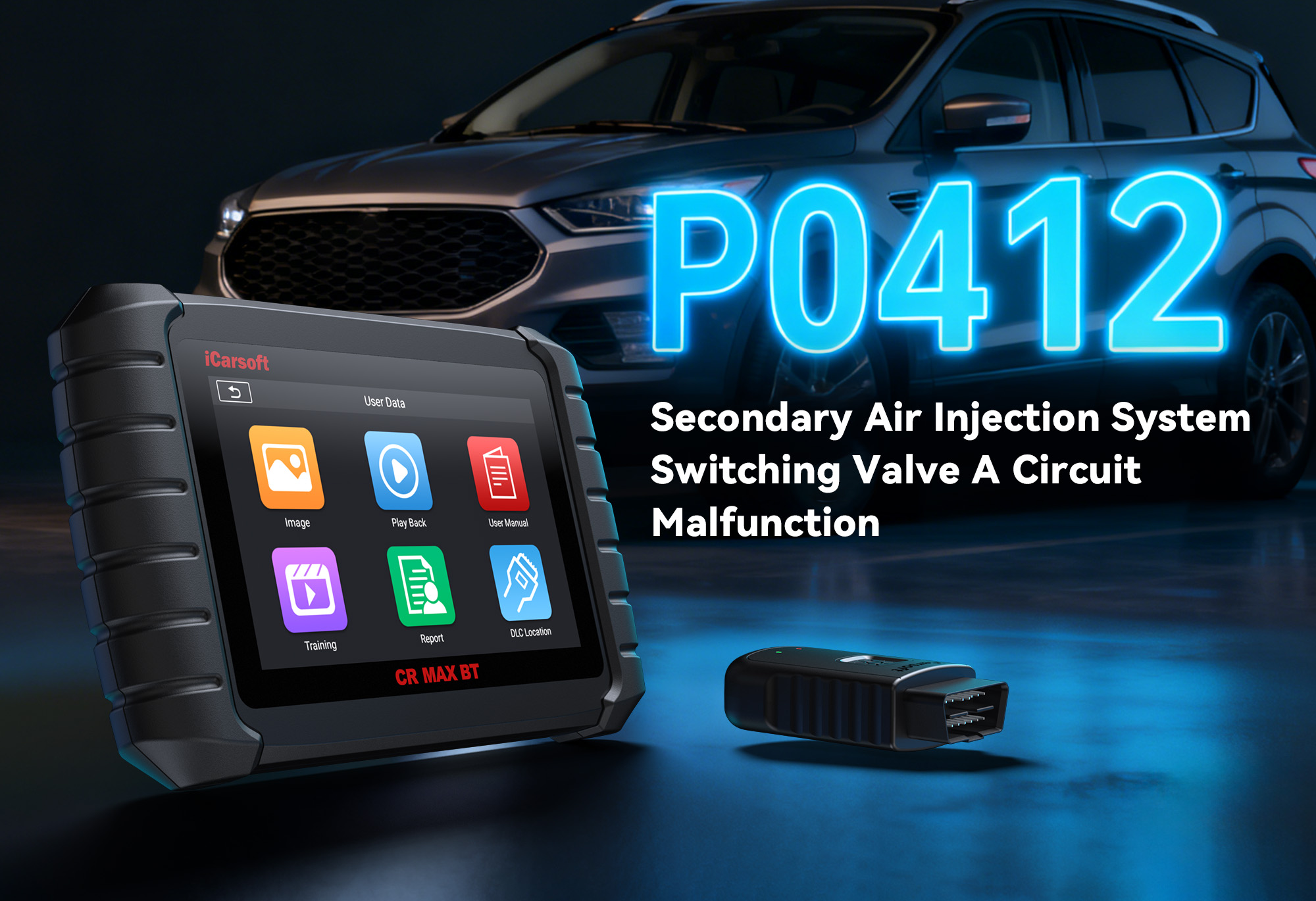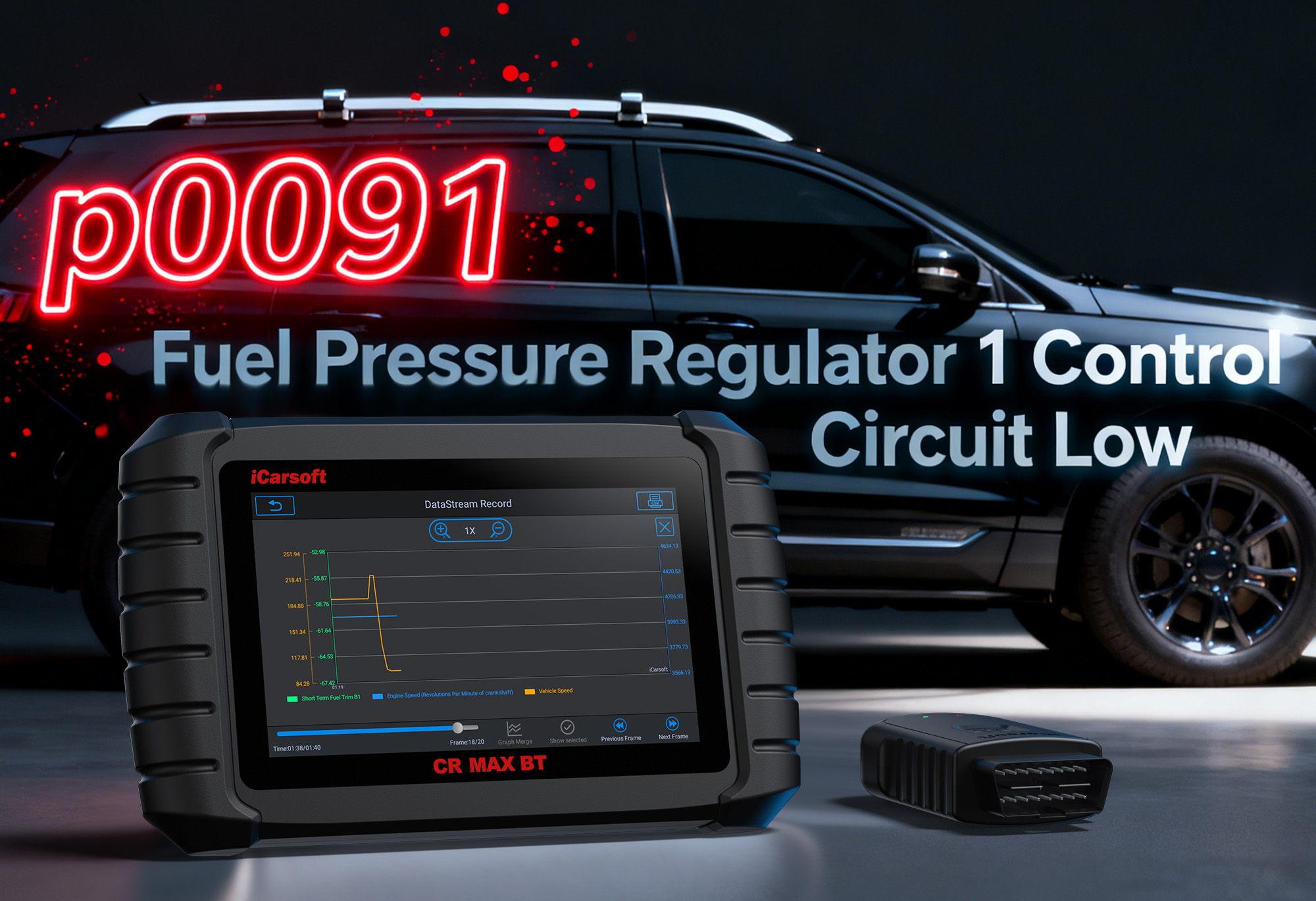Clear P1451 with iCarsoft CR MAX BT: Fix EVAP Fuel Tank Pressure Issues
If your check engine light turns on and a scan reveals P1451, you’re dealing with a problem in your vehicle’s Evaporative Emissions (EVAP) system—specifically the fuel tank pressure regulation. Common in Ford, Lincoln, and Mercury models (though found in other makes too), this code translates to “Unable to Bleed Off Fuel Tank Pressure,” meaning the EVAP system can’t release built-up pressure in the fuel tank as designed.
The EVAP system prevents harmful fuel vapors from escaping into the atmosphere by storing them in a charcoal canister, then purging them into the engine to be burned. A key part of this system is maintaining proper pressure in the fuel tank: too much pressure can damage seals or hoses, while too little can cause vapor leaks. When P1451 strikes, the Engine Control Module (ECM) detects that pressure isn’t bleeding off correctly, triggering the check engine light.
Basic scanners might only confirm “EVAP fault” but fail to pinpoint whether the issue is a clogged vent valve, faulty pressure sensor, or loose gas cap. The iCarsoft CR MAX BT—with its wireless design and advanced EVAP diagnostics—changes this. Equipped with Bluetooth connectivity, real-time pressure monitoring, and vehicle-specific EVAP tests, it simplifies diagnosing and clearing P1451. Below is a complete guide to the process.
Key Code Definition:
P1451: “Unable to Bleed Off Fuel Tank Pressure” — The ECM detects that the EVAP system can’t release excess pressure from the fuel tank, usually due to a stuck vent valve, clogged tube, or pressure sensor error. Most common in Ford, Lincoln, and Mercury vehicles but affects other makes with similar EVAP designs.
First: Understand P1451—What It Means & Why It Happens
Effective diagnosis starts with understanding how the EVAP system regulates fuel tank pressure and the common triggers for P1451. This code isn’t just a “vapor leak”—it’s a sign of pressure buildup that the system can’t resolve.
How the EVAP System Regulates Fuel Tank Pressure
The EVAP system’s pressure control loop ensures the fuel tank stays at a safe pressure level (typically -1.5kPa to +3kPa):
-
Fuel Tank Sealing: The tank is sealed to trap fuel vapors (prevents atmospheric pollution). As temperatures rise (e.g., sitting in sunlight), fuel expands and vaporizes, increasing tank pressure.
-
EVAP Vent Valve: A solenoid-controlled valve (usually near the charcoal canister) opens to release excess pressure. When pressure exceeds +3kPa, the ECM commands the valve to open, letting fresh air in and equalizing pressure.
-
Fuel Tank Pressure Sensor: Mounted on the tank or canister, it sends real-time pressure data to the ECM. If the sensor detects pressure stays high after the vent valve is commanded open, P1451 triggers.
-
Charcoal Canister: Stores vapors until the engine is warm enough to burn them. It also acts as a filter, preventing debris from entering the vent valve.
Key Symptoms of P1451
Illuminated Check Engine Light
The most common symptom—P1451 rarely causes drivability issues (no hesitation or power loss). The light stays on until the pressure issue is fixed and the code is cleared.
Difficulty Opening the Gas Cap
Excess tank pressure creates suction, making the gas cap hard to twist open. You may hear a “hiss” when the cap is finally removed—this is trapped pressure escaping.
Failed Emissions Tests
P1451 flags the EVAP system as non-compliant with EPA standards. Most states reject vehicles with active EVAP codes during emissions testing.
Hissing from the Fuel Tank Area
Rare but critical: If pressure builds too high, it may escape through weak seals (e.g., tank seams or hose connections). A persistent hiss indicates a potential safety risk—address immediately.
Related EVAP Codes
P1451 often appears with P0442 (small EVAP leak) or P0455 (large EVAP leak) if pressure buildup damages hoses or seals, creating secondary leaks.
Common Causes of P1451
Faulty EVAP Vent Valve
The #1 cause: The valve’s solenoid fails, leaving it stuck closed. Corrosion (from road salt) or debris (from the canister) jams the valve, preventing pressure release. Common in vehicles with 60,000+ miles.
Clogged EVAP Vent Tube
Dirt, mud, or insects (e.g., wasps building nests) block the vent tube that connects the canister to the valve. Even if the valve opens, pressure can’t escape through a clogged tube.
Loose or Damaged Gas Cap
A surprisingly common trigger: A worn gas cap seal or loose fit disrupts pressure regulation. The ECM detects “unexpected pressure changes” and flags P1451 (always check this first—it’s a $20 fix!).
Faulty Fuel Tank Pressure Sensor
The sensor sends incorrect pressure data to the ECM (e.g., reads +5kPa when actual pressure is +2kPa). This tricks the ECM into thinking the vent valve isn’t working, triggering P1451.
EVAP System Leaks
Holes in hoses or cracks in the charcoal canister disrupt pressure control. While leaks usually cause “low pressure” codes (P0442), severe leaks can confuse the ECM, leading to P1451.
Why iCarsoft CR MAX BT Excels at P1451
P1451 requires testing EVAP pressure dynamics and validating component functionality—tasks basic scanners can’t handle. The CR MAX BT’s features are tailored to solve these challenges, saving you from costly guesswork (e.g., replacing a $150 vent valve when the issue is a $20 gas cap).
Step-by-Step: Diagnose P1451 with iCarsoft CR MAX BT
Follow this structured process to pinpoint the root cause of P1451. The CR MAX BT eliminates guesswork, ensuring you fix the real issue—not just the code.
-
1. Connect the CR MAX BT & Confirm P1451
-
Plug the CR MAX BT’s OBD-II adapter into your vehicle’s port (under the dashboard). Power on the tool, enable Bluetooth, and pair it with the adapter (follow on-screen prompts—takes 10–15 seconds).
-
Select your vehicle’s make (e.g., Ford, Lincoln, Chevrolet) and use Auto VIN to auto-detect your model/year/engine (e.g., 2018 Ford Escape 1.5T). This ensures you get OEM-specific EVAP specs.
-
Navigate to Engine > Fault Codes > Read Codes to confirm P1451 is present. Tap Code Details for vehicle-specific context (e.g., “Ford F-150: EVAP Canister Vent Valve Stuck Closed—Pressure >5kPa for 3 Minutes”).
-
Note related codes (e.g., P0442 = small leak, P0455 = large leak)—these may explain why P1451 is occurring (e.g., a leak damaged the vent valve).
-
2. Start with the Simplest Fix: Check the Gas Cap
A loose or damaged gas cap is the #1 overlooked cause of P1451—verify it first to avoid unnecessary repairs:
-
Turn off the engine and remove the gas cap. Inspect the rubber seal for cracks, tears, or debris (e.g., dirt, old fuel residue). Ensure the cap’s threads are clean and undamaged.
-
Reinstall the cap, tightening it until you hear 3–4 distinct clicks (this ensures a proper seal). Do not overtighten—this damages the seal over time.
-
Use the CR MAX BT to temporarily clear P1451: Navigate to Fault Codes > Clear Codes, select P1451, and confirm deletion.
-
Take a 10-minute test drive (include stop-and-go traffic to cycle the EVAP system). Re-scan for codes after driving:
-
No P1451 = Gas cap was the issue. Replace it if the seal is worn (use the CR MAX BT’s Part Lookup for OEM caps, e.g., Ford BL3Z-9030-C).
-
P1451 returns = Move to Step 3 (EVAP system issue).
-
3. Analyze Real-Time EVAP Pressure Data
-
Go to Engine > Live Data > EVAP System and select these 3 critical parameters (use “Add to Favorites” to track them side-by-side):
-
“Fuel Tank Pressure (kPa)” (normal range: -1.5kPa to +3kPa when parked)
-
“EVAP Vent Valve Status” (should toggle “Open/Closed” as pressure changes)
-
“EVAP Pressure Sensor Voltage” (corresponds to pressure—rises with increasing pressure)
-
Park the vehicle in direct sunlight (or let it idle for 15 minutes to build pressure) and monitor the data:
-
P1451 Confirmation: Pressure rises above +5kPa, but “Vent Valve Status” stays “Closed” (valve is stuck). Sensor voltage also stays high, confirming excess pressure.
-
Leak Clue: Pressure fluctuates randomly (e.g., +4kPa → +1kPa → +3kPa) without valve movement—signals a leak in hoses or canister.
-
Sensor Fault Clue: Pressure reads +1kPa, but sensor voltage shows +5kPa (incorrect reading)—replace the pressure sensor.
-
4. Test the EVAP Vent Valve with Bi-Directional Control
This step confirms if the vent valve is mechanically functional (the most common P1451 cause):
-
Step 1: Locate the Vent Valve — Use the CR MAX BT’s Component Location tool. The valve is usually near the rear axle, attached to the charcoal canister, with a 2-pin electrical connector and a rubber vent tube.
-
Step 2: Run the Valve Test:
-
Navigate to Special Functions > EVAP System > Vent Valve Test.
-
Turn the ignition to “On” (engine off) and follow on-screen prompts:
-
Select “Command Vent Valve to Open” — Listen for a faint “click” (solenoid activating). “Fuel Tank Pressure” should drop by 2–3kPa within 30 seconds.
-
Select “Command Vent Valve to Close” — Another click. Pressure should stabilize (stop dropping) within 10 seconds.
-
Interpret Results:
-
No click + no pressure change = Faulty vent valve (replace it—Step 5).
-
Clicks but pressure doesn’t drop = Clogged vent tube (clean it—Step 5).
-
Clicks + pressure changes = Valve is functional—check for sensor or leak issues.
-
5. Inspect & Repair EVAP Components
Based on the valve test and pressure data, address the root cause:
-
Clogged Vent Tube:
-
Disconnect the vent tube from the valve and charcoal canister (use pliers to loosen hose clamps).
-
Blow compressed air (low pressure: 30 psi) through the tube to clear dirt, insects, or debris. If the tube is severely clogged, replace it (use the CR MAX BT’s Part Lookup for OEM tubes).
-
Reconnect the tube securely and re-run the vent valve test to confirm pressure drops.
-
Faulty Vent Valve:
-
Disconnect the valve’s electrical connector and remove mounting bolts (usually 10mm socket).
-
Use the CR MAX BT’s Part Lookup to find the OEM replacement (e.g., Motorcraft EV278 for Ford, AC Delco 214-2045 for GM).
-
Install the new valve, reconnect the connector and vent tube, and torque bolts to specs (e.g., 8 Nm).
-
EVAP Leaks:
-
Use the CR MAX BT’s EVAP Leak Test (under Special Functions) to identify leak locations. The tool pressurizes the system and alerts you to pressure decay.
-
Repair small holes in hoses with EVAP-rated tape (e.g., 3M Super 33+). Replace severely damaged hoses or cracked charcoal canisters.
-
Faulty Pressure Sensor:
-
Locate the sensor (on the fuel tank or canister) using the CR MAX BT’s Component Location.
-
Disconnect the electrical connector, remove the sensor, and replace it with an OEM part (e.g., Ford BL3Z-9F972-A).
-
6. Clear P1451 & Verify Repairs
Ensure the fix is permanent by confirming the EVAP system works correctly:
-
Step 1: Clear the Code — Navigate to Engine > Fault Codes > Clear Codes and delete P1451. Ensure no related EVAP codes remain.
-
Step 2: Run EVAP System Relearn (Ford/Lincoln Models):
-
For Ford, Lincoln, or Mercury vehicles, go to Special Functions > EVAP > System Relearn.
-
Follow prompts: Turn ignition “On” for 10 seconds, then start the engine and idle for 5 minutes. This resets the ECM’s EVAP pressure thresholds.
-
Step 3: Verify Repairs:
-
Take a 30-minute test drive (include highway speeds and stop-and-go traffic—EVAP systems require varied conditions to complete a “monitor cycle”).
-
Use the CR MAX BT’s Data Logging to record fuel tank pressure and vent valve status during the drive. Ensure pressure stays within -1.5kPa to +3kPa.
-
Re-scan after driving: No P1451 + stable pressure = Fix is successful.
-
Code returns: Double-check for hidden leaks (e.g., under the fuel tank) or a faulty ECM (use the CR MAX BT’s ECM Health Check to verify).
Pro Tip for Ford/Lincoln Owners: Many Ford vehicles (2015+) have a “EVAP Vent Valve Filter” that clogs with dirt over time. Use the CR MAX BT’s Component Location to find the filter (attached to the vent valve) and replace it annually. A clogged filter mimics a stuck valve, triggering P1451—and it’s only a $10 part!
How to Prevent P1451 from Recurring
The CR MAX BT helps maintain a healthy EVAP system, avoiding future P1451 codes with proactive care.
-
1. Check the Gas Cap Monthly
-
Use the CR MAX BT’s Maintenance Reminder to schedule monthly gas cap checks. Ensure it’s tight (3–4 clicks) and the seal is intact.
-
Replace the gas cap every 3 years—rubber seals dry out and crack over time, even if the cap looks undamaged.
-
2. Inspect the EVAP Vent Valve Annually
-
Use the CR MAX BT’s EVAP Health Scan (under Quick Tests) to test the vent valve’s functionality. Run the bi-directional test to confirm it opens/closes properly.
-
For vehicles in cold climates, inspect the valve for corrosion (road salt damages solenoids). Clean corrosion with electrical contact cleaner if needed.
-
3. Avoid Overfilling the Fuel Tank
-
Stop fueling when the pump clicks off—overfilling saturates the charcoal canister with liquid fuel, leading to clogs and valve damage. This is a top cause of P1451 in Ford vehicles.
-
The CR MAX BT’s Fuel System Monitor alerts you to “excessive fuel tank pressure” if you overfill, letting you correct the issue before P1451 triggers.
-
4. Clean Vent Tubes in Dusty/Off-Road Environments
-
If you drive on dirt roads or off-road, use compressed air to clear the EVAP vent tube quarterly. Follow the CR MAX BT’s EVAP Maintenance Tips for step-by-step guidance.
-
Install a vent tube filter (OEM or aftermarket) to prevent debris from entering the system—available for most Ford, GM, and Toyota models.
-
5. Update ECM Software
-
Use the CR MAX BT’s One-Key Upgrade to install manufacturer ECM updates. Some P1451 cases are caused by outdated EVAP pressure thresholds—updates fix these calibration issues.
-
Check for updates every 6 months—the tool alerts you to new releases for your specific vehicle.
FAQ: Common Questions About P1451
Q: Can I drive my vehicle with P1451, or will it cause damage?
A: Short-term driving (1–2 weeks) is usually safe, but long-term use risks:
-
Damage to fuel tank seals or hoses (from sustained high pressure).
-
Secondary EVAP leaks (pressure can rupture weak hoses).
-
Failed emissions tests (preventing vehicle registration in most states).
-
In rare cases: Fuel pump damage (excess pressure disrupts fuel flow).
Fix P1451 within a month to avoid costly secondary repairs.
Q: Why does P1451 come back after I replace the vent valve?
A: The most common reasons are
unaddressed clogs or
sensor issues:
-
You replaced the valve but didn’t clean the vent tube—debris still blocks pressure release.
-
The fuel tank pressure sensor is faulty—sends incorrect data to the ECM, triggering P1451 even with a new valve.
-
You used an aftermarket vent valve—many generic valves don’t meet OEM pressure specs (always use OEM parts).
Use the CR MAX BT’s pressure sensor test to rule out sensor faults.
Q: How much does it cost to fix P1451?
A: Costs vary widely based on the cause—simple fixes are cheap, while component replacements cost more:
-
Gas cap replacement: $20–$50 (DIY).
-
Vent tube cleaning: $0–$20 (DIY with compressed air).
-
EVAP vent valve replacement: $50–$150 (OEM part + DIY) or $150–$300 (dealer install).
-
Pressure sensor replacement: $80–$200 (OEM part + DIY) or $200–$400 (dealer install).
The CR MAX BT saves you money by pinpointing the cause—avoiding $300+ dealer diagnostics.
Q: Does P1451 affect fuel economy?
A: No—P1451 is an emissions issue, not a fuel delivery problem. The EVAP system only handles fuel vapors, not liquid fuel flow to the engine. You won’t notice a drop in MPG with P1451. However, if P1451 is paired with other codes (e.g., P0171 = lean mixture), fuel economy may suffer due to the secondary issue.
Summary Table: P1451 Diagnosis & Repair Steps
|
Step
|
Action with iCarsoft CR MAX BT
|
Common Fix
|
|
1
|
Scan Engine system; confirm P1451 + check related EVAP codes
|
Identify fuel tank pressure bleed-off issue
|
|
2
|
Inspect gas cap; clear code + test drive to verify
|
Replace worn gas cap or re-tighten to 3–4 clicks
|
|
3
|
Monitor live fuel tank pressure + vent valve status
|
Pinpoint stuck valve, clogged tube, or sensor fault
|
|
4
|
Run bi-directional vent valve test to confirm functionality
|
Replace faulty valve or clean clogged vent tube
|
|
5
|
Inspect/repair EVAP components (hoses, canister, sensor)
|
Fix leaks or replace pressure sensor if needed
|
|
6
|
Clear code; run EVAP relearn (Ford/Lincoln); test drive + re-scan
|
Verify stable pressure + no recurring P1451
|
Final Thoughts
P1451’s “fuel tank pressure” label might seem complex, but it often traces to simple fixes—like a loose gas cap or clogged vent tube. The iCarsoft CR MAX BT simplifies diagnosis with its wireless tools, real-time pressure monitoring, and bi-directional tests, helping you avoid costly dealer visits or unnecessary part replacements.
Whether you’re a DIYer with a Ford F-150 or a technician servicing a Lincoln MKZ, the CR MAX BT ensures you resolve P1451 quickly and correctly. Its vehicle-specific EVAP specs and guided tests take the guesswork out of emissions system repairs, letting you focus on fixing the real issue.
Don’t let an EVAP fault keep your check engine light on. With the CR MAX BT, you have everything you need to clear P1451, pass emissions tests, and keep your vehicle’s environmental impact in check. Take control of your EVAP system today—your vehicle (and the planet) will thank you.





